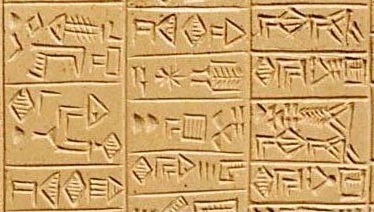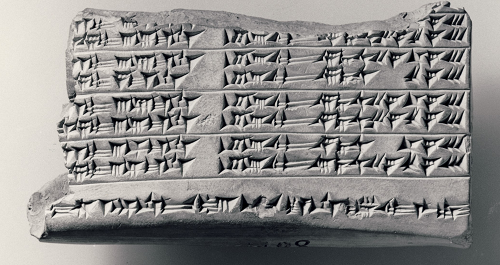Cuneiform
History
Originating in the land of Sumer, the cuneiform script is one of the three independently invented writing systems of the world from which all known scripts evolved . It is also very likely the first writing system ever invented .
Early sumerian world around 3000-2500 BCE ( © British Museum)

The neo-assyrian empire around
630 BCE
The different cuneiform systems used in the region served as a carrier for multiple languages --from the unrelated Sumerian to the first written Indo-european language (Hittite)-- and covered all the possibilities of written expression; from mundane receipts to literary masterpieces like the Gilgamesh Epic as well as personal letters, international correspondence, law codes, scientific texts (mathematical, linguistic, astronomic, medical...), religious texts (hymns, prayers...), historic texts, political texts and even proto-philosophical texts. With the evolution of the Alphabet (c. 1200 BCE) and the decline of the Mesopotamo-centric culture from 600-500 BCE onwards, cuneiform was used less and less, until it vanished in the first century CE.
Clay Tablets
The cuneiform script was strongly conditioned by the material it was written upon: clay. As anyone who has tried to write on clay may have noticed, this material is not what we could call “curvefriendly” and does not lend itself very well for naturalistic drawings. When cuneiform was invented, it was, technically, not a true cuneiform, as no wedges were used. The first signs were of a strong naturalistic form (akin to the Egyptian hieroglyphs) and one can recognize many familiar forms while looking at an archaic cuneiform text. However, the Sumerians were conditioned by clay as we are today and were rapidly forced to adapt the signs to the medium used. Instead of curvy pictures engraved with a stylus on clay, they started to write the signs by impressing the stylus in the clay, getting rid of the curves and shaping the signs by means of the wedge-shaped impressions of the stylus, hence the name cuneiform (from Latin cuneus, “wedge”).
An example of early cuneiform (26th century BCE)
Even if clay tablets are remarkably sturdy, we are dealing with archaeological finds and as such, clay tablets have a wide conservation spectrum.


Two examples of badly preserved tablets: broken and completely worn out (left) or broken, worn out and rather small text-wise (right)
This is the first and most important challenge when dealing with them, not only for automatizing purposes but for general assyriological work as well. Clay tablets might be broken, have their surface completely worn out , be just too small text-wise or all of the above (see above). And, as we are dealing with handwritten documents, the writing might not be as clear as we would like (for example: tightly written signs, referred to as ligatures).
Our tablet
For the purpose of this first project, we decided to concentrate our efforts on the best preserved tablet we had at our disposal, since it seemed to be the most promising one for testing the edge-detection approach.VAT 8619 (click on the image for the full-resolution picture) is a beautiful example of a well written tablet with clear, nicely separated signs. It's a piece of a greater tablet (the inferior right edge of it, actually) and it has been already edited by Ernst Weidner (AfO 12, p147) . It is an astronomical text listing the duration of the night on the first and 15th day of each month. Our file is a scan of the original analog picture from the Assur Archive in Heidelberg, while the original tablet sits in the Vorderasiatisches Museum in Berlin.
